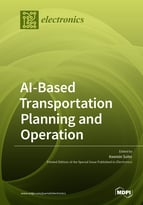AI-Based Transportation Planning and Operation
A special issue of Electronics (ISSN 2079-9292). This special issue belongs to the section "Electrical and Autonomous Vehicles".
Deadline for manuscript submissions: closed (15 November 2020) | Viewed by 18777
Special Issue Editor
Interests: transportation; transportation planning
Special Issues, Collections and Topics in MDPI journals
Special Issue Information
Dear Colleagues,
With drastic urbanization, cities around the world are facing transportation-induced problems such as congestion, accidents, and air pollution. Transportation planning and operation provides opportunities to satisfy the demand for the movement of people and goods in a safe, economical, convenient, and sustainable manner. Previous studies of transportation planning and operation have depended upon econometrics- or engineering-based modeling, which cannot fully incorporate the power of data-driven or AI-based approaches. Recently, artificial intelligence (AI) technologies, such as deep learning, reinforcement learning, and Bayesian modeling, have provided powerful tools to deal with the complexity and high nonlinearity in the problems of transportation planning and operations. More specifically, AI-based technologies in decision-making, planning, modeling, estimation, and control have facilitated the process of transportation planning and operations. The purpose of this Special Issue is to provide an academic platform to publish high-quality research papers on the applications of innovative AI algorithms to transportation planning and operation. Prospective authors are invited to submit original research and review articles related to the applications of AI or machine learning techniques to transportation planning and operation. The potential topics of interest include but are not limited to the following:
- Big data analytics in transportation
- Data-driven transportation modeling and simulation
- AI-based traffic surveillance
- Traffic operations and management
- Road safety enhancement
- AI-based transportation network design
- Decision-making on transportation issues
- Car sharing technologies
- Pedestrian movement analysis
- Vehicle emission management
- Mobility data analysis for evacuation
Prof. Dr. Keemin Sohn
Guest Editor
Manuscript Submission Information
Manuscripts should be submitted online at www.mdpi.com by registering and logging in to this website. Once you are registered, click here to go to the submission form. Manuscripts can be submitted until the deadline. All submissions that pass pre-check are peer-reviewed. Accepted papers will be published continuously in the journal (as soon as accepted) and will be listed together on the special issue website. Research articles, review articles as well as short communications are invited. For planned papers, a title and short abstract (about 100 words) can be sent to the Editorial Office for announcement on this website.
Submitted manuscripts should not have been published previously, nor be under consideration for publication elsewhere (except conference proceedings papers). All manuscripts are thoroughly refereed through a single-blind peer-review process. A guide for authors and other relevant information for submission of manuscripts is available on the Instructions for Authors page. Electronics is an international peer-reviewed open access semimonthly journal published by MDPI.
Please visit the Instructions for Authors page before submitting a manuscript. The Article Processing Charge (APC) for publication in this open access journal is 2400 CHF (Swiss Francs). Submitted papers should be well formatted and use good English. Authors may use MDPI's English editing service prior to publication or during author revisions.
Keywords
- transportation planning and operation
- artificial intelligence
- big data
- machine learning
- data-driven approach






